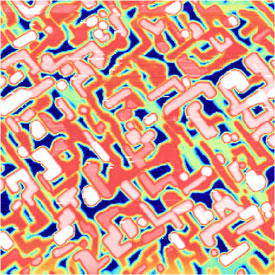

12/25/2018

Adapted with permission from Ref 1. Copyright 2018 American Chemical Society.
A system created by AIMR researchers consisting of an ultrathin metal film on a high-temperature superconductor is a promising host for elusive particles known as Majorana fermions1. Such a platform could lead to new applications in spintronics and quantum computing.
Matter is made up of protons, neutrons and electrons, which are all examples of fermions — particles that have half-integer spins (for example, spins of 1/2 and 3/2). Every fermion has an antiparticle, which has the same mass as the particle but the opposite sign for one of its quantum properties (such as its charge). For instance, the antiparticle of the negatively charged electron is the positively charged positron.
Over eight decades ago, Italian theoretical physicist Ettore Majorana predicted the existence of a special fermion that is its own antiparticle, the so-called Majorana fermion. While Majorana fermions have yet to be observed as elementary particles, they could appear as quasiparticles — excitations in materials that behave as particles — in some special material systems.
So-called topological superconductors are particularly promising systems for supporting Majorana fermions. “The lowest energy state of topological superconductors has been theoretically predicted to form a superconducting gap in the electronic state of the bulk and gapless state at surfaces and edges, which should lead to the emergence of Majorana fermions,” explains Katsuaki Sugawara of the AIMR at Tohoku University. “Consequently, many researchers are intensively studying topological superconductors with the goal of finding Majorana fermions.”
Now, Sugawara and colleagues have produced a hybrid material that they strongly suspect is a topological superconductor. They grew a six-atom-thick film of bismuth on top of a bismuth strontium calcium copper oxide superconductor and analyzed it using electron microscopy and spectroscopy techniques. Their analysis suggests that the hybrid material is a candidate topological superconductor. If it does turn out to be topological superconductor, there is a high chance it could be used to produce Majorana fermions.
Unlike other superconducting systems explored in previous studies, the one fabricated by Sugawara and his team superconducts at a high temperature and has a relatively large superconducting gap, both of which are advantageous for establishing it is a topological superconductor and for looking for Majorana fermions.
“We believe our new platform could harbor long-sought-after Majorana fermions that are stable at high temperatures,” says Sugawara. “And it could help realize novel applications in spintronics and quantum computing.”
The researchers are doing further experiments that will definitively show whether the system is a topological superconductor and can host Majorana fermions.
This research highlight has been approved by the authors of the original article and all information and data contained within has been provided by said authors.